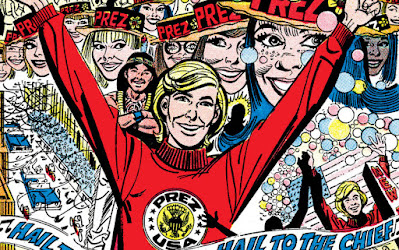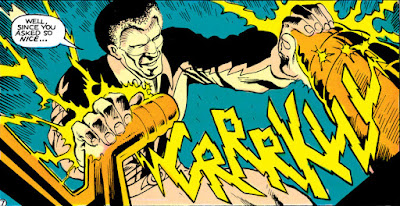Prez: The First Teenage President is a wonder-soaked product of the Bronze Age, created by Captain America co-creator Joe Simon and artist Jerry Grandenetti. While only having four issues, the character did appear in 1973's Supergirl #10 by Cary Bates, Saaf, and Vince Colletta. In this story, the first teenage president interacts with Supergirl after she saves Prez from being assassinated. No other heroes are mentioned, but Prez does relate how Supergirl flew him to the safety of the Fortress of Solitude.
That prompted some speculation about the existence of Supergirl in Prez's world. Were there any other heroes in that world? Superman apparently exists or did exist to give Supergirl her identity, but who else? Is the Sandman story about Prez's fate after leaving office count? If so, then Wildcat is in this alternate Earth as well. However, since Supergirl has access to the Fortress of Solitude, and with no mention of Superman, the thought came that Prez might exist in a world where Superman is dead, and Supergirl took over for him. The world of Superman #149 from 1961 is one such world where Lex Luthor kills Superman.
The Crisis on Infinite Earths Absolute Edition puts Prez's story occurring on Earth-72, denoted by the year Prez debuted. Superman #149 is an imaginary story taking place on Earth-149. The tale in Sandman #52 is told as a story, with Dream appearing at the end, claiming jurisdiction of Prez's fate as "the prince of stories." This ending to Prez's journey should likely not be considered canon, but nothing directly contradicts anything. The Crisis on Infinite Earths Absolute Edition firmly notes it happening on Earth-72.
The problem also comes when Supergirl #10 is cited in the Crisis on Infinite Earths Absolute Edition as occurring on Earth-12. In re-reading the issue, the second story could easily be the odd placement, but nothing in it has the demented requirements of Earth-12. If the first Supergirl story in the issue is on Earth-12, then that alternate reality has its own version of Prez, where his canceled fifth issue occurred, according to the listing of alternate realities.
If the theory is correct, Earths 12, 72, and 149 are all the same world. This means Prez's world has Bizarro, Batman, Robin, Green Arrow, the Flash, Aquaman, Wonder Woman, and the Legion of Super-Heroes. With Earth-12, there are also the unique characters from The Inferior Five, the youthful Green Team, Joker, Riddler, Penguin, Mister Freeze, Captain Cold, Abra Kadabra, and Plastic Man. The only wrinkle comes in Superman's appearance in Adventures of Jerry Lewis #92 and #105. Of course, this can be explained by a parallel world where Superman survived Lex Luthor's plan, or it's a time-traveling Superman from before 1961. Of course, that means Superman knew that he was going to die sometime before he met Jerry Lewis. It's probably better to ignore them if the theory is going to hold.
Then again, Earth-12 might just be it's own thing apart from Earth-72 and Earth-149.



























